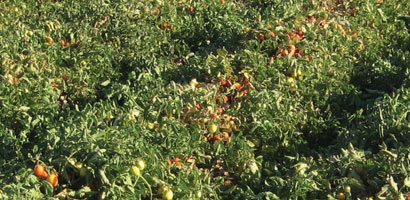2011 has been declared the Year of the Tomato by The National Garden Bureau and for good reason—recent developments in tomato breeding are putting this valuable fruit into the spotlight.
Tomatoes have attracted the limelight recently with the release of new varieties with improved agronomic, functional and nutritional characteristics. Recent developments in tomato breeding offer prolonged shelf life, increased disease resistance and improved marketability of this fruit.
Nunhem’s, a subsidiary of Bayer Crop Science, has developed the world’s first non-leaking tomato, Nunhems’ Intense, which can be sliced or diced without losing its shape. The company has also bred a tomato variety for India, Laxmi, which can tolerate higher temperatures during growth and offers improved virus resistance and increased productivity.
Professor John Scott of the University of Florida has developed a vine-ripened tomato variety called Tasti-Lee, which has a deeper red color, improved flavor and more antioxidants than other varieties due to its increased lycopene content. The variety is currently being launched into the marketplace by Bejo Seeds Inc.
Avtar Handa, a professor of horticulture at Purdue University, has produced a transgenic tomato that stays fresh longer with the addition of a yeast gene that increases the production of a compound called spermidine that slows aging and delays microbial delay.
Breeding Tactics
There are many ongoing tomato breeding research programs and they all have different methods and aims and are driven by different factors.
Some research employs the use of biotechnology and genetic modification to identify the various genes responsible for different functionalities within different varieties of tomato plants, and develop DNA markers for those genes, so that desirable characteristics can be incorporated into breeding programs for new, improved varieties.
Not all breeding programs employ the same techniques. HeinzSeed, the tomato breeding division of the H. J. Heinz Company L.P., is producing hybrid varieties through conventional plant breeding techniques for a large sector of the tomato processing industry.
Agronomic issues like yield and pest and disease resistance are huge factors driving a lot of research, particularly in the case of the tomato seed industry. “By and large, yield still drives tomato seed sales,” says John Stommel, the vegetable and fruit research leader at the USDA’s laboratory in Beltsville, Maryland.
Another important factor is field storage capacity which is crucial to make sure only ripe, sound fruit reaches the factory. “The quality of the fruit coming in is important,” says Rich Ozminkowski, manager of agricultural research for HeinzSeed. “A trait that we include in many of our varieties is extended field storage, which allows the first ripe fruit to stay in good condition while the grower awaits the later fruit to mature.”
For tomato growers it comes down to simple economics, says Stommel, with yield issues driving research. “As long as we have fungicides and insecticides and pesticides to deal with those problems [research] will continue to be yield driven,” he says. “But if we can develop the complete package; if we had a high-yielding tomato with these other improved attributes as well, it would be a winner.”
Research Goals
Commercial factors such as shelf life, processing attributes, size and uniformity of appearance are important to both the processing and fresh tomato industries and also drive research into improving these qualities.
Stommel, who primarily conducts research aimed at the processing industry, is investigating the color and texture (including firmness) of tomatoes. “We are beginning to look at the genetics of pigments in different parts of the tomato fruit,” he says. “The work we have done to date clearly shows that there is independent genetic control for color in different tissue types. It’s a finer approach to optimizing color.”
Trait qualities like color uniformity and firmness have an impact upon the quality and marketability of tomatoes in both the processing and fresh tomato sectors. But, although many of these characteristics have been successfully bred into modern tomato varieties, this has sometimes been at the expense of other valuable traits. “During breeding, we have bred for longer shelf life but have lost a lot of other good characteristics like flavor and some of the nutrients,” says Handa.
It’s difficult to maintain a high quality in fruit and vegetable crops under current production systems, explains Stommel. “Either the system has to change or we need to develop a tomato which will deliver better quality under that type of production system,” he adds.

Scott’s breeding program has successfully combined the different factors of commercial production, agronomy and consumer demands. Tasti-Lee is a high-quality tomato cultivar that he hopes will be a good fit for consumers willing to pay a little more for better taste and nutrition, while earning a premium price for growers, who will pay increased labor costs to harvest this vine-ripened variety.
Emphasis on Field-Grown Sector
But a much larger project currently underway as part of Scott’s breeding program recognizes that a wider strategy will be necessary in the future to help the field-grown tomato industry in Florida and other growing regions of North America compete in a market environment increasingly dominated by greenhouse-grown produce and cheaper imports from countries with lower production costs like Mexico.
Scott and his team are developing fresh market varieties which should be available in a couple of years. These new varieties have concentrated fruit set that requires no staking, are jointless (meaning they can be picked free of stems) and can be machine-harvested similar to processing tomatoes, but harvested at the mature green stage of development. The scenario Scott hopes to offer growers is the ability to spread their risk by combining the two varieties; so they can concentrate labor on a higher value crop like Tasti-Lee which can absorb the additional expense, and also reduce costs on the machine-harvested varieties, harvested mature green for lower priced markets.
Looking Ahead
Future tomato breeding research will continue to be driven by some of the same factors that drive it now but, as global weather patterns change, their impact upon growing conditions could require greater adaptability in varieties.
“In our programs we are trying to choose varieties that are the most adaptable across the broadest range of environments and conditions,” says Ozminkowski.
HeinzSeed has been involved in global research that has successfully identified and developed tomato varieties that are well adapted to local soil and climate conditions in countries like China, Egypt and the Ukraine.
There will also be continued emphasis on better pest and disease resistance, says Stommel. Besides trying to develop resistance to familiar diseases, researchers are increasingly focusing on new pathogens like the geminivirus, a disease now limited to tropical regions, but, if spread to other growing regions, could be devastating.
Scott’s program is working on a transgenic tomato variety that will offer protection from two of the most devastating tomato diseases for his growers: tomato yellow leaf curl virus and bacterial spot.
“A gene in pepper called BS2 has been inserted into tomatoes by genetic transformation,” says Scott. “It’s a gene that works very well against the strains of bacteria that cause bacterial spot in Florida and provides a really good level of resistance which can be used to develop resistant hybrids. In the meantime, we are putting TYLCV resistance, which we have already developed, into the hybrids. So we will eventually have a tomato with resistance to TYLCV through conventional breeding, and bacterial spot through genetic transformation, and growers will have one variety that will not be susceptible to the two most serious diseases that affect their production.”
Ultimately the challenge for the entire perishable food industry is to continue to offer increasing volumes of attractive, flavorful, healthy food at prices that people can afford, while maintaining a viable and sustainable economic return for each level of the industry from the grower through to the retailer.
Consumer is Key
One of the keys to doing this, says Handa, is using technology like genetic modification to allow perishable fruits like tomatoes to be marketed for a longer period of time.
“If you can enhance the ability to store fruit for a longer time, that gives the horticulture industry advantages like cheaper transportation costs,” says Handa. “And if you enhance shelf life, you also provide a higher quality product that is healthier and gives higher returns.”
Consumers expect consistent high quality, good value and safety from the foods they consume, things the tomato industry is striving to deliver.
“As a company that is very close to its consumers, it’s important that we take their needs and expectations into account and that our varieties reflect them,” says Ozminkowski. “Traceability is very important. One of the benefits for our company is that we control our supply chain and so we can trace the seed right through to the bottle and even back to the breeding records.”
As new tomato varieties continue to hit the market offering improved shelf life, flavor, nutrition and other attributes, the consumer is the one who will ultimately decide the success of those varieties by accepting transgenic technology and employing their taste buds and wallets. Angela Lovell











